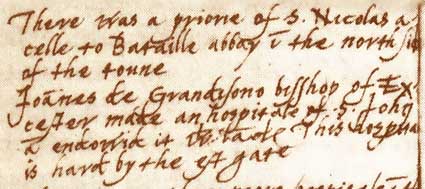|
John
Leland (Leyland) was appointed King’s Antiquarian in
1533 and authorised by King Henry VIII to have access to
the libraries of Cathedrals, Abbeys, Priories and any other
places where records and ancient writings were stored. In
this way he collected and transcribed many documents which
almost certainly would have been lost, or at least dispersed,
during the dissolution of the monasteries (which began in
1536). In order to complete this task he travelled widely;
visiting, among other places, Somerset (in 1533), York (1534)
and St. Albans (1535). He became interested in the places
he visited, as well as the documents he called to see, and
maybe was already starting work on his next project...
In
1539 he began travelling England and Wales again. This time
his purpose was to make first hand observations to write
a book to be entitled "History and Antiquities".
He completed these travels in 1545, and on his return wrote:
"there
is almost neyther cape nor baye, haven, creke or pere, ryver
or confluence of ryvers, breches, washes, lakes, meres,
fenny waters, mountaynes, valleys, mores, hethes, forestes,
woodes, cyties, burges, castels, pryncypall manor places,
monasteryes, and colleges, but I have seane them, and noted
in so doynge a whole worlde of thynges verye memorable."

Above,
a passage from one of Leland's notebooks. It refers to his
visit to Exeter in 1542:
"There
was a priorie of s. Nicolas a celle to Bataille abbay i
the north side of the toune.
Joanes de Grandesons bisshop of Excester made an hospitale
of s. John a endowid it the lande. This hospitale is hard
by the est gate."
Unfortunately
this work was never completed; he became insane in 1550
and died in 1552. However, his notes were so detailed, including
historical and geographical data, that they became invaluable
to later scholars.
So
far we (at Caerleon Net) have been unable to locate unedited
text relating to Caerleon. The following quotes have been
drawn from an article by WN Johns, which appeared in Monmouthshire
Medley, Volume One (see references). Some of
the language and spelling has been brought up to date, while
elsewhere the original has been preserved.
"Newport
is but 2 miles from Cairleon. From Newport to the place
where Ebouith goith on to Wisch Haven a good mile and a
halfe. And then more then a half mile to the Haven Mouth.
The Bridges of Cairleon and Newport be both of wood.
From the Haven Mouth of Wisch to the Mouth of Remmy, wher
no Haven is or coming in mete for shippes, about III miles.
On this shore is no very notable Thing. The Bankes of it
be clyvid inough to defend the Se for ranging into the Low
Ground of Wenceland. Newport is a bigge Towne whereof that
parte where the Paroche Chirch is standith on a Hill. The
Chirch is S. Guntie Olave in English. There is a great stone
gate by the Bridge at the Este Ende of the Town, another
yn the middle of the town as in the High Strete to passe
through, and the 3 at the west end of the towne; and hard
without is the paroche church. The fairest of the town is
all yn one streat. The towne is in ruine. The castelle is
in the este ende of the town above the bridge. There was
a house of religion by the key beneth the bridge.
Some
say that Caerleon should be in Base Ventland; some say nay.
The Welshmen say that Caerleon is but VIII miles from Chepstow,
but, indeed, it may be counted XII English miles. It standeth
magnificently on the further side of Wische, one of the
principal rivers of Wales, so that the great ships might
well come now to the town as they did in the Romans’
time, but that Newport Bridge is a lett. Nevertheless, big
boats come to the town. The ruins of the wall of the town
yet remain, and also of the castle. There is opinion that
the old Roman Church was about Mr. X's house, where I lay.
There on digging appeared certain paintings on stones. There
were found at late certain incrustments hard by the castle.
In the town is now but one parish church and that is of
St. Caducus."
Notes:
Leland
says Gwent comprised three divisions, viz., Low, Middle,
and High Venteland, and extended from Chepstow to Newport
on one side, and to Abergavenny on the other; the latter
of which he says “maketh the
cumpace of Hye Venteland.”
He
describes Wentloog as being “divided
from Ventifla by este (east) with the ryver Wiske (Usk),
by south with the Severn Se, by west with the ryver of Remny
to the very hedde of it, and towards the north north est
by the hills of High Wenteland."
References:
Leland's
Description of Gwent, in the Time of Henry VIII,
W N Johns, Monmouthshire Medley Volume One, Reginald Nicholas.
The
Life of John Leland (The First English Antiquary).
From a manuscript believed to have dated from the middle
of the 18th Century. Alfred Cooper, 1896 (Copy in Newport
Reference Library.)
John
Leland's Itinerary, Travels in Tudor England,
by John Chandler, 1993, Sutton Publishing. NB Unfortunately
this does not include Leland's travels in Wales!
We
leave the last words to John Leland:
"I
trust so to open this wyndow, that the lyght shal be seane,
so long, that is to say, by the space of a whole thousand
yeares stopped up, and the old glory of your renoumed Britaine
to reflorish through the worlde."
[Top
of page]
|